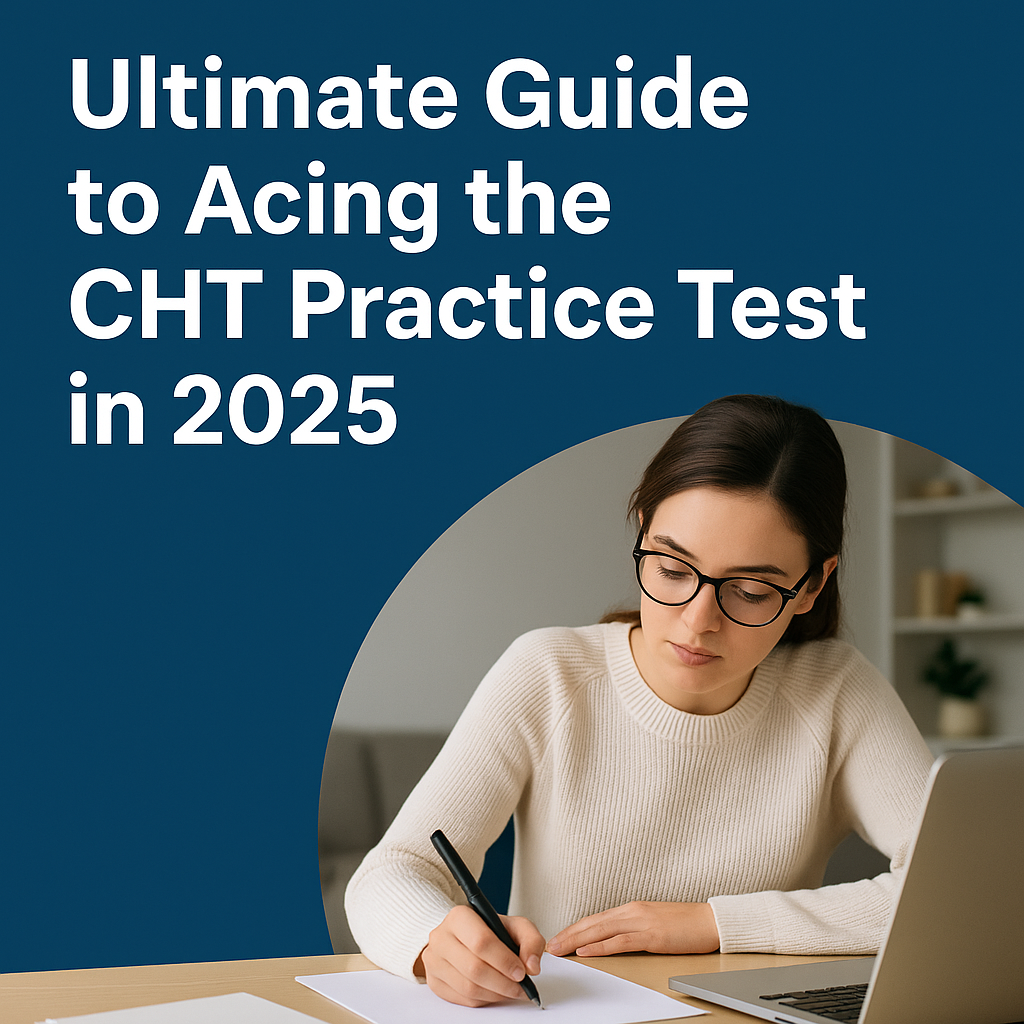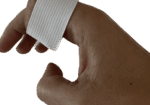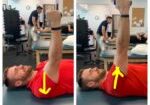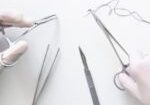Ultimate Guide to Acing the CHT Practice Test in 2025
Filed under Uncategorized
Introduction to the CHT Certification
What Is the CHT Exam?
The Certified Hand Therapist (CHT) exam is a rigorous credentialing exam that validates advanced clinical skills in upper limb rehabilitation. Administered by the Hand Therapy Certification Commission (HTCC), it’s designed for occupational and physical therapists who specialize in hand therapy. Passing this exam signifies a therapist’s deep expertise in treating injuries and conditions from the shoulder to the fingers.
Who Should Take the CHT Practice Test?
If you’re planning to sit for the CHT exam, taking a practice test is a critical step. Occupational therapists (OTs) and physical therapists (PTs) with at least 3 years of clinical experience and 4,000 hours in hand therapy should make practice tests a routine part of their preparation strategy.

Importance of the CHT Practice Test
Why Practice Tests Are Essential
Practice tests are more than a rehearsal—they are a self-assessment tool. They simulate the actual exam experience, helping reduce anxiety, refine pacing, and reveal weak areas. Many successful CHT candidates credit practice tests for improving their confidence and boosting their scores.
How They Improve Success Rates
Practice tests allow repeated exposure to real-style questions, which reinforces memory and increases familiarity with test logic. Studies show that candidates who consistently take mock tests are more likely to pass on their first attempt compared to those who rely solely on reading materials.
Structure of the CHT Practice Test
Number of Questions and Format
The official CHT exam consists of 200 multiple-choice questions. Practice tests often mirror this format to give you an accurate simulation. Typically, they are timed to match the actual 4-hour exam duration.
Key Topics and Domains Covered
The test spans across several major domains:
- Evaluation
- Therapeutic interventions
- Orthotic fabrication
- Anatomy and physiology
- Clinical reasoning
Practice tests often reflect the same weighted structure so you can prepare comprehensively.
Content Areas to Focus On
Anatomy and Physiology
Expect detailed questions on the structure and function of the musculoskeletal, nervous, and vascular systems of the upper limb. Understanding nerve innervation and blood supply is vital.
Therapeutic Techniques
These include modalities like ultrasound, paraffin, manual therapy, and proprioceptive training. Practice tests often include scenario-based questions that test your ability to choose the most effective intervention.
Evaluation and Assessment
You must know how to interpret goniometry readings, strength testing results, and various functional assessments. Practice questions usually challenge your clinical decision-making skills.
Splinting and Modalities
Prepare to answer questions about splint selection, design, fitting, and materials. Practice tests may present clinical cases that require you to select the optimal orthosis.
Best Resources for CHT Practice Tests
One of the best online platforms for practicing the CHT Test is Hand Therapy Academy. Here you can find a full-length CHT Practice Test as well as a free demo version.
Recommended Books
- Rehabilitation of the Hand and Upper Extremity by Hunter
- Orthotic Intervention for the Hand and Upper Extremity
Sample CHT Practice Test Questions and Answers
Multiple Choice Example Questions
- Which nerve innervates the flexor pollicis longus?
- A. Radial
- B. Ulnar
- C. Median ✅
- D. Axillary
- A. Radial
- A patient has a boutonnière deformity. Which splint is most appropriate?
- A. Dorsal blocking splint
- B. Static extension splint ✅
- C. Wrist cock-up splint
- D. Volar plate splint
- A. Dorsal blocking splint
Rationales and Explanations
Each practice question should include explanations. For example, the median nerve innervates the flexor pollicis longus, which helps with thumb flexion—critical in opposition tasks.
How to Use CHT Practice Tests Effectively
Test Simulation Strategies
Always take your practice tests under timed conditions to simulate real pressure. Turn off distractions, use a timer, and sit at a desk.
Time Management Techniques
Divide your exam into four 1-hour blocks. Pace yourself at roughly one question every 1.2 minutes, leaving some time at the end for review.
Study Plan for CHT Exam Preparation
30-Day Study Guide (repeat as needed)
| Day Range | Focus Area |
| Days 1–7 | Anatomy Review |
| Days 8–14 | Splinting & Modalities |
| Days 15–21 | Evaluation Techniques |
| Days 22–28 | Practice Exams |
| Day 29 | Review Missed Questions |
| Day 30 | Full-Length Mock Test |
Weekly Breakdown & Tips
Break each week into 2–3 content modules. Rotate between reading, testing, and reviewing. Stay consistent and avoid cramming.
Mistakes to Avoid While Preparing
Skipping Review of Wrong Answers
Don’t just look at your score—analyze your incorrect answers. Understanding why you got something wrong is key to retention.
Memorizing Without Understanding
Knowing facts isn’t enough. The CHT exam tests application of knowledge. Focus on clinical reasoning.
CHT Exam Day: What to Expect
Registration and Requirements
Register through HTCC’s website. Make sure you meet eligibility requirements, including licensure and work hours.
Exam Environment and Policies
You’ll take the exam at a Prometric testing center. Bring two forms of ID and arrive early. No phones, notes, or calculators allowed inside.
How to Analyze Your Practice Test Results
Identifying Weak Areas
Use your practice test scores to pinpoint trouble spots—whether it’s anatomy, splinting, or patient assessment.
Creating a Targeted Review Plan
Spend 60% of your review time on weak areas and 40% reinforcing strengths. Rotate topics every 2–3 days.
Recommended Study Groups and Forums
Online Communities for Support
- OT/PT Facebook Groups
- Reddit’s r/OccupationalTherapy
- HTCC’s Community Forum
Peer Review and Discussions
Studying with others helps reinforce learning. Try explaining your answers out loud—teaching is a powerful memory tool.
Professional Tips from Certified Hand Therapists
Top Advice from Recent Passers
- “I did one full-length practice test every weekend.”
- “Flashcards saved my life for memorizing nerve pathways.”
Mindset and Motivation Techniques
Stay positive and visualize success. Even when you feel overwhelmed, remember why you started—helping patients thrive.
FAQs About the CHT Practice Test
Is the CHT practice test similar to the real one?
Yes, most reputable tests mimic the format and difficulty of the actual exam.
How many times should I take practice tests?
At least 3–5 full-length mock exams before test day is ideal.
What is the pass rate?
The pass rate fluctuates around 60-70% annually.
Do questions repeat?
Not exactly, but concepts and scenarios often overlap.
Can I retake the practice test multiple times?
Yes. In fact, repeated exposure to the same questions can strengthen recall.
Conclusion
The CHT practice test is your secret weapon to conquering the real exam. With a structured study plan, high-quality resources, and the discipline to review thoroughly, success is well within reach. Embrace the journey and trust in your preparation.
More To Read
Splinting Options for Stiff Finger Joints
Following an injury to the proximal interphalangeal joint, there is often a loss of range of motion, typically in both the flexion and extension planes. Therefore, we have compiled a list of helpful splinting options for stiff finger joints. To Improve PIP Joint Flexion Flexion Wrap with Elastic Tape (Coban): This is a very easy…
Read MoreIncreasing Shoulder Range of Motion by improving Scapulohumeral Rhythm
Scapulohumeral rhythm is often the key component when treating shoulder conditions and the reason for the lack of total shoulder range of motion. This may also be a critical component in order to prevent shoulder conditions during rehabilitation of other upper extremity conditions such as distal radius fractures, tendon injuries, and elbow injuries. Scapulohumeral rhythm…
Read MorePlace-and-Hold Versus Active Mobilization Therapy After Flexor Tendon Repair
Title: Passive Mobilization With Place-and-Hold Versus Active Mobilization Therapy After Flexor Tendon Repair: 5-Year Minimum Follow-Up of a Randomized Controlled Trial Article Review By: Tommi Hintnaus Reference: Chevalley, S., Wangberg, V., Ahlen, M., Stromberg, J., & Bjorkman, A. (2024, October 4). Passive Mobilization With Place-and-Hold Versus Active Mobilization Therapy After Flexor Tendon Repair: 5-Year Minimum…
Read MoreWhat? I just received an order for suture removal…
How many of us have practiced suture removal in occupational or physical therapy school?? NOT I!! Often, hand surgeons will ask the therapist to remove sutures and sometimes the order will even say “remove sutures when ready” SO NOW WHAT? How to remove continuous sutures? First, we can cover the basics of sutures! There are…
Read MoreSign-up to Get Updates Straight to Your Inbox!
Sign up with us and we will send you regular blog posts on everything hand therapy, notices every time we upload new videos and tutorials, along with handout, protocols, and other useful information.






